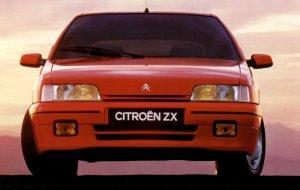Citroen had a gap in their range in the early ‘90s
The BX was being replaced by the larger Xantia, whilst the AX felt smaller than the Visa had done. The arrival of the ZX in 1991, followed by an estate version in 1993, filled the gap.
Mechanically, it was exactly what you’d expect – the choice of engines was almost exactly the same as the BX & Xantia, and the suspension was a coil-sprung version of the usual MacPherson strut front and trailing arm rear. The bodyshell was lightly built, giving decent performance, whilst fuel economy – especially in the 1.9D non-turbo was excellent. The styling was not startling, but carried a strong family resemblance both up and down the range.

Some neat features were included, not least the addition of passive rear-steer bushes to the rear suspension. As cornering forces increased, the subframe was permitted a degree of lateral movement. Together with careful packaging to keep mechanical masses inside the wheelbase, the ZX was a surprisingly fun car to drive, with engines up to a 150bhp 2.0 16v available, although most of the plaudits went to the more solidly built and attractively styled twin, the Peugeot 306.
Inside, neat detail design included a rear seat on all bar base trim models which could be slid forwards and backwards, allowing a trade-off between boot space and rear passenger legroom.

As with so many other Citroen models of the era, the ZX had a minor mid-life facelift – in 1995 – to carry it through to replacement in 1997 by the Xsara.
Despite a very attractive Heuliez concept car, the 1994 Vent d’Ouest, no convertible ZX was ever released – it was reserved for the 306. The 3-door was marketed as a ‘coupe’, however, with the 16v engine never being seen in the 5-door. The ‘warm-hatch’ 1.8 Furio was similarly 3-door only.
This very Heuliez concept car was sold at auction through Artcurial based in Le Mans on 7th July 2012. A total one-off car showing just 22 kilometers:
Ex-Salon de Paris 1994
The Citroën ZX was supposed to fit in between the AX and the ageing BX. The two bodies, a five-door saloon and a 3-door coupé, were seen as widening choice to attract a younger clientele. Following this logic, the presence of a cabriolet was seen as the best way to boost the image of this somewhat ordinary model. In March 1994, with the marque’s agreement, Heuliez began designing a four-seater cabriolet, and he presented the prototype at the Paris Motor Show in October 1994, under the delightful name ‘Vent d’Ouest’. Using the platform of the coupé, the rear overhang was increased by 13 cm, which gave the ‘Vent d’Ouest’ a larger boot than the standard coupé, despite the space needed for the hood casing. Developed in strict collaboration with ASC, the specialist supplier for cabriolets with electric hoods, the car received an enthusiastic response from the public. However, the management at PSA did not want to create competition for its Peugeot 306 cabriolet. Moreover, the ZX range was by then four years old, and the design team were already working on its successor, the Xsara. The ‘Vent d’Ouest’ project had arrived too late! The elegant ZX convertible therefore remained unique, making it more desirable today.This running prototype, built on the platform of a ZX that came off the production line, is in superb condition. It has a maroon soft top and an attractive interior with brick red leather and patterned fabric. The car displays just 22 km on the odometer. It is powered by a four-cylinder 16-valve petrol engine mated to a five-speed gearbox. The car has never been registered, but is in running condition, the engine belt has been recently changed. Extremely elegant and finished to a high standard, this superb hand-built concept-cabriolet would have merited production. Today, being unique makes it even more special.


